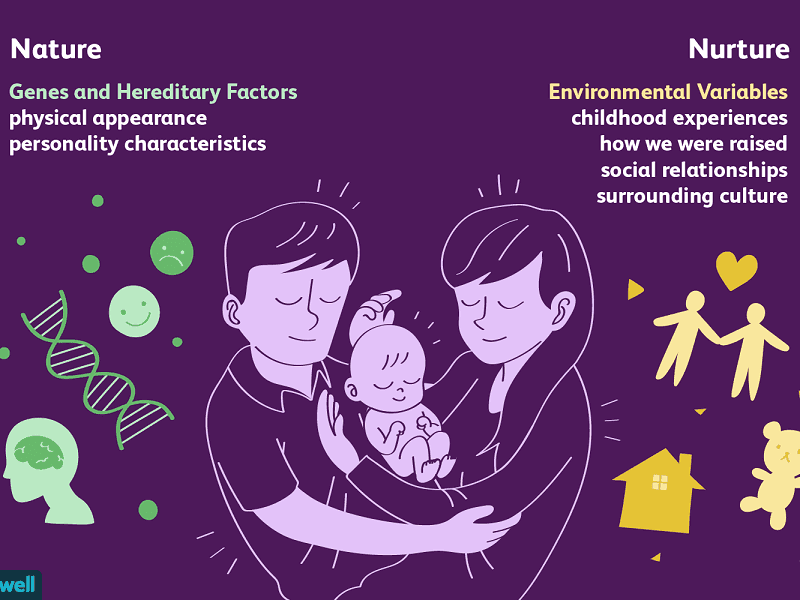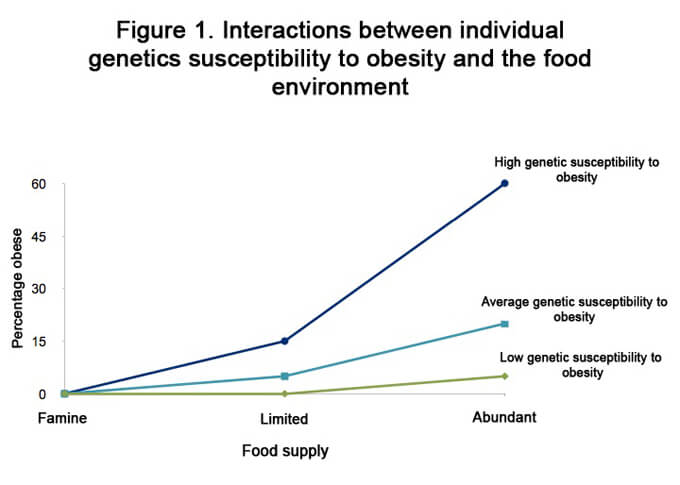
introduce
Obesity is a global epidemic; its prevalence is increasing , and began to develop during childhood. Therefore, it is vital to determine the underlying accidental factors of initial weight gain. Recent environmental changes – such as increasing the chance of eating high-calorie foods and reducing the chance of physical activity – have undoubtedly played a role. Despite this, not everyone is overweight. Weight has a strong genetic basis, leading to hypothetical genes that may affect the extent to which individuals gain weight in a modern environment. Genetically determined sensitivity to the environment will help explain the role of obesity in genetics and the environment.
Subject
Eating behavior or appetite has been proposed as a mechanism of genetic influence on obesity susceptibility. In particular, those who inherit a stronger appetite – high responsiveness to external food cues and low sensitivity to internal satiety (satisfaction) processes – may be more likely to take advantage of the diverse dietary opportunities brought about by the modern environment , And therefore gain more weight. In other words, genes may affect the size of an individual’s appetite, and eventually these genes will affect their weight, which is the so-called “genetic behavior prone to obesity.”
Questions and research background
Eating behaviors of interest are behaviors that have evidence of causality for early weight gain. Broadly speaking, these behaviors can be considered “food proximity” behaviors, indicating greater appetite, greater interest in food (for example, food enjoyment and reaction to external food cues), and a tendency to gain weight, and “Food avoidance” behaviors indicate better appetite regulation, decreased interest in food (for example, sensitivity to fullness and slower eating speed) and prevent weight gain. Observational measurement of eating behavior provides detailed information, but is time-consuming and expensive, so the number of observations is limited, which is problematic for genetic studies that require large samples (see below). Participants may also change their eating behaviors as a result of observations, especially adults with overweight self-consciousness. Using children instead of adults can help solve this problem. Parental reporting indicators for children’s eating behavior (Children’s Eating Behavior Questionnaire [CEBQ] or Infant’s Eating Behavior Questionnaire [BEBQ]) have been enabled to use information for a series of eating behaviors. Reliably collect on very large samples.
Two different methods allow researchers to explore the influence of genetics on eating behavior. The so-called “quantitative inheritance” research broadly estimates the extent to which behavior is influenced by genes or the environment. The study compared family members with different genetic relatedness-if genetically similar relatives are also more similar in eating behavior, then genetic influence is inferred. Twins are usually used because identical twins (monozygotic and dinuclear, MZs) are 100% genetically identical, while different or “sibling twins” twins (dizygotic and dinuclear, DZs) have an average of only about 50% of the genes, such as conventional brothers and sisters. At the same time, it can be assumed that MZ and DZ share environmental factors to a very similar degree (for example, they were born in the same family at the same time), so they can be compared. Compared with DZ, the similarity between MZ is higher, indicating that genes affect eating behavior. Heritability is a statistic derived from twin studies, which indicates to what extent individual differences in a sample are explained by genetic variation. The statistics range from 0% (genetic variation does not cause individual differences) to 100% (individual differences can be completely explained by genetic variation). The limitation of twin studies is that they cannot tell us the actual genes involved, they just show the relative importance of genes and the environment.
Molecular genetics research attempts to identify specific genes. Early studies looked at individuals and families with extreme performance characteristics—for example, severe early-onset obesity—to find genes. The genes identified in these studies are responsible for rare and serious genetic diseases, but uncommon genes affect changes in the entire population (for example, weight). Combining recent technological advances with the completion of the Human Genome Project in 2000, using a method called genome-wide association (GWAS), it is possible to explore the impact of millions of genetic variations on the characteristics of a wider population. Quantitative genetic research requires a large sample, and molecular genetic research requires a larger sample.
Main research questions
- Can eating behavior be inherited?
- Which genes influence eating behavior?
- Do weight-related genes affect weight through dietary behavior?
Latest research results
The high heritability of weight in children and adults (approximately 70%) is a long-term discovery, derived from a large number of twin and family studies. Similar estimates of heritability have been found for the eating behavior of infants and children. CEBQ was used in 5,435 pairs of 10-year-old British twins to demonstrate that most individual differences in responsiveness to food cues and satiety responsiveness are genetically determined (75% and 63%, respectively). At the age of 11, the eating rate observation index (63%) of the 254 subsamples of these twins received similar estimates. Infant version of CEBQ (BEBQ) in 2,402 pairs of infant twins, the heritability estimates of food enjoyment (53%), food responsiveness (59%), satiety response (72%) and slow eating (84%) Relatively high. The same sample of twin babies can also be used to show that about one-third of the eating behavior affects the weight. It supports the idea that genes and their effects on eating behavior will affect the weight of the genes.
Early studies on obese individuals and families found that a major mutation in one of the few genes leads to severe early-onset obesity, extreme appetite greed and lack of obvious satiety. The basic regulatory leptin pathway of these genes controls the center of hunger and satiety, and is located in an ancient part of the brain called the hypothalamus. Although the discovery of these gene mutations provides important insights into the biology of weight and eating behavior, they are extremely rare and therefore cannot explain population-level weight changes.
Genome-wide Association Studies (GWAS) have identified more than 30 common genetic variants associated with adult and child weight. The first to be discovered was “obesity and obesity-related genes”, FTO. Nearly half of us carry at least one weight-related FTO variant; and the two of us carrying two are on average 3 kg heavier than those who do not carry two. FTO is not only mainly expressed in the hypothalamus, but is also related to the observation index of food responsiveness measured during the test meal, and is related to the satiety responsiveness measured by CEBQ. Many other variants found through GWAS are also expressed in the hypothalamus, indicating that common genetic variants, such as rare mutations, affect body weight through eating behavior. However, the relationship between these other common variants and eating behavior has not been explored so far.
Research gap
Although research has made progress in determining that dietary behaviors (such as weight) have a strong genetic basis, we know very little about the specific genes involved. A good starting point is to explore whether the weight-related common genes identified so far are also related to eating behavior. The biology that links genes to behavior also needs to be characterized. In addition, testing the feasibility of changing the eating behavior of individuals genetically predisposed to obesity is crucial. So far, there are few studies on changing eating behaviors, but some studies are promising. Epstein and his colleagues succeeded in slowing down the eating rate of seven children for six months by encouraging them to put down their knife and fork after each bite. Another study showed that cultivating 4-5 year old children can better recognize and take care of their internal satiety.
in conclusion
Studies of twins have confirmed that the differences in eating behaviors between people and me are partly explained by genetic variation, which is typical of Western society at this time; although the actual genes involved have yet to be identified. Twin studies also show that the same genes that affect eating behavior also affect body weight, indicating that the size of an individual’s appetite will ultimately affect their vulnerability to obesity in a modern tolerant environment. To support this, the most important common weight-related gene (FTO) seems to affect weight through its influence on children’s susceptibility to satiety. The susceptibility of this so-called genetic behavior to obesity helps overcome the seeming paradox of genetic and environmental determination of weight.

The figure is a hypothetical example of the percentage of obese children under three different environmental conditions based on whether they have a low, average, or high genetic susceptibility to obesity. In the case of famine, regardless of the genetic susceptibility to obesity, there will be no obese children; when the food supply is limited, children with high genetic susceptibility will be obese than children with average susceptibility, but children with low genetic susceptibility will be obese. Will not be obese; under abundant conditions (such as the modern food environment in the United States), most children with high genetic susceptibility will be obese. The average genetic susceptibility is quite large, but few children with low genetic susceptibility will be obese.
Influence on parents, services and policies
This study shows that due to the existence of genes, some people are more susceptible to overeating to cope with the many opportunities brought by the modern food environment, and are more likely to gain weight. This makes people doubt the concept of personal responsibility for obesity. It is generally believed that the weight of a child reflects the parenting strategy of the parents. However, this study shows that some children (more commonly the parents are overweight and therefore may inherit higher-risk genes, may find it more difficult than others to properly regulate their food intake because they have stronger This appetite is partly due to the genes inherited by the parents. This can make it more difficult to resist excessive consumption in response to the many dietary opportunities presented by the modern environment.
An effective strategy may be to strengthen national supervision of the wider food environment to reduce opportunities and incentives for excessive consumption, such as removing vending machines from schools, more stringent control of food marketing to children, and restrictions The number of fast food establishments and the supervision of supermarket layout. Parents can also change the family environment-for example, by cooking a small amount of dinner to eliminate the temptation of “seconds”, keeping problem food out of sight (or better, not at home), and teaching children how to recognize feelings of fullness.














